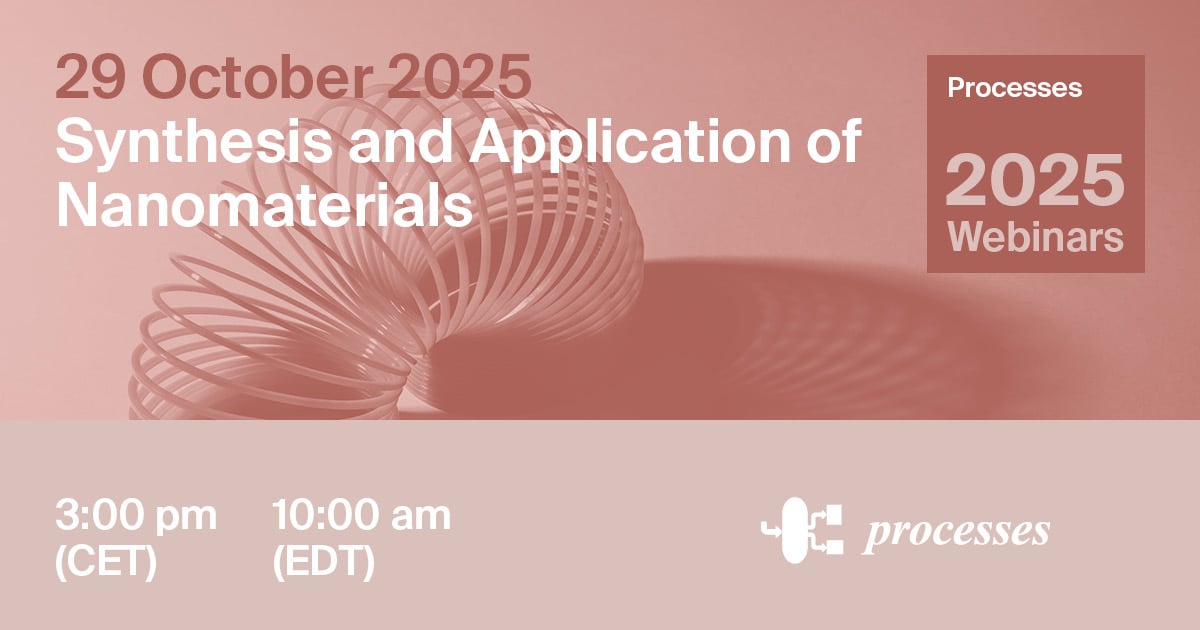Conferences
29 October 2025, Online
Processes Webinar | Synthesis and Application of Nanomaterials, 29 October 2025

Over the past few decades, many fields of science and technology have been revolutionized by the introduction of nanomaterials and new approaches to the creation of nanostructures. These new materials can have entirely unique or improved electronic, chemical, magnetic, catalytic, mechanical, or biological properties that are different from bulk forms of the material. Nanomaterials range from nanoparticles of various shapes and compositions to nanostructured films, coatings, and nanoporous bulk materials. Chemical, physical, or biological methods can be used to produce nanomaterials, ranging from precise top-down methods such as nanolithography to bottom-up methods, including self-assembly. Thermal, chemical, and electrochemical processes can all result in the formation of nanomaterials. Additionally, the range of materials covers many types of nanomaterials based on various forms of carbon, silicon, metals or alloys, and polymers. These materials are contributing to revolutionary advances in the fields of medicine, energy, chemical and biological sensing, agriculture, catalysis, and many others. This webinar features three speakers covering a selection of topics in nanomaterial research and applications.
Date: 29 October 2025
Time: 3:00 p.m. CET | 9:00 a.m. EDT
Webinar ID: 831 8919 0501
Register now for free!
Program:
| Program and Content | Time (CET) |
| Prof. Keith Stine Chair Introduction |
15:00–15:10 |
| Prof. Mattia Bartoli Carbon Dot Conundrum: A Chemical Perspective Nanostructured materials have attracted a great deal of interest in recent years, and the number of applications proposed for them has boomed. Their use in the biological environment has become a ‘hot’ issue. Several applications have in fact been proposed, such as drug delivery, cancer therapy, localized heating, and biological probes. All these uses are supported by scientific reports and papers that assess nanomaterial viability and outstanding properties. However, when the bridge from proof of concept to real-world product needs to be crossed, as human beings are involved, requirements on material characterization become very stringent. Without a thorough characterization, in fact, it is not possible to check nanoparticle reproducibility and hence assess that they will behave in the same way with respect to the desired application as well as biocompatibility. In this talk, we will focus on carbon dots, i.e., carbon-based almost 0 d (size of a few nm) nanostructures. Carbon dots can be produced in different ways, even starting from natural-derived chemicals like citric acid and urea. After a brief description of a few routes to produce carbon dots, we will focus on their structural composition in order to establish a strong correlation between chemical features and physicochemical properties. |
15:10–15:30 |
| Prof. Karen Esquivel Escalante Bio-nanomaterials as Novel Fertilizers and Stimulants in the Agricultural Sector Nanomaterials (NMs) have become a significant tool in agriculture by enhancing crop production, protection, and sustainability. They offer innovative solutions to address climate change, soil degradation, and food security challenges. NMs improve the efficiency of fertilizers and pesticides, facilitating better absorption and reducing waste. Also, NMs enhance plant growth by increasing chlorophyll content, root and shoot lengths, and stress tolerance. They also aid in seed germination and nutrient uptake, leading to better crop yields. By optimizing resource use and reducing waste, nanotechnology in agriculture promotes environmental stewardship and cost-effectiveness. Several studies are showing diverse approaches to deliver NMs into the plant–soil system for maximum benefits and the lowest consequences, trying to make this practice as sustainable as possible. The effects depend on the type of plant/crop, then, how the NMs are delivered to the vegetal system, the concentration, the morphology or shape, their nature, surface charge, and whether the NMs may form agglomerates. However, NM use in agriculture also raises concerns about potential toxicity and environmental impacts, necessitating careful regulation and risk assessment. Ensuring public acceptance of nanotechnology in agriculture requires transparent communication about its benefits and risks, alongside robust regulatory frameworks. Balancing innovation with safety will be crucial for the sustainable integration of nanotechnology in agriculture. |
15:30–15:50 |
| Dr. Gregorio Guadalupe Carbajal Arizaga Hybrid Layered Double Hydroxides as Multifunctional Platforms in Biomedicine This talk will present a strategy for synthesizing hybrid layered double hydroxide (LDH) particles with antioxidants, focusing on stabilizing both their biological activity and commercial formulation. It will also demonstrate how the same process can be used to obtain these compounds directly from their natural source. It will address how LDH can be modified to preserve the low dimensionality and give rise to multifunctional materials with biomedical applications of great interest, from contrast agents for MRI to controlled drug delivery vehicles, representing an emerging approach in nanomedicine. Specific examples of antioxidants will be discussed, demonstrating how these materials enhance the stabilization and enable their commercial application. Finally, the challenges, such as the control of biocompatibility, the scalability of synthesis, and the projection towards clinical applications, will be discussed. |
15:50–16:10 |
| Q&A Session | 16:10–16:25 |
| Prof. Keith Stine Closing of Program |
16:25–16:30 |
After registering, you will receive a confirmation email with information on how to join the webinar. Registrations with academic institutional email addresses will be prioritized.
Unable to attend? Feel free to register anyway; the session will be recorded, and we will let you know when the recording is available for viewing.
Webinar Chair and Speakers:
- Prof. Keith Stine, Department of Chemistry and Biochemistry, University of Missouri–Saint Louis, Saint Louis, MO, USA;
- Prof. Mattia Bartoli, Polytechnic of Turin and Italian Institute of Technology, Italy;
- Prof. Karen Esquivel Escalante, Graduate and Research Division, Engineering Faculty, Universidad Autónoma de Querétaro, Cerro de las Campanas, Querétaro, Mexico;
- Dr. Gregorio Guadalupe Carbajal Arizaga, Chemistry Department, University of Guadalajara, Mexico.
Relevant Special Issue:
“Synthesis and Applications of Nanomaterials”
Guest Editor: Prof. Dr. Keith J. Stine
Deadline for manuscript submissions: 30 November 2025
For more information about this webinar, please visit the following website: https://sciforum.net/event/Processes-14?subscribe.
If you have any questions about this event, please contact processes@mdpi.com.
Processes Webinar Secretariat





